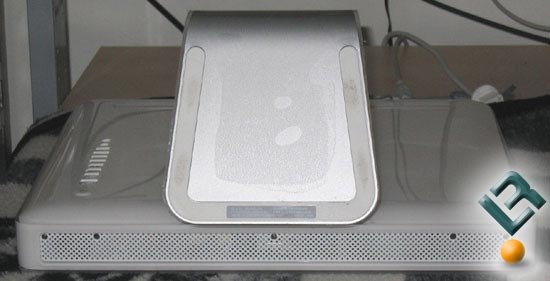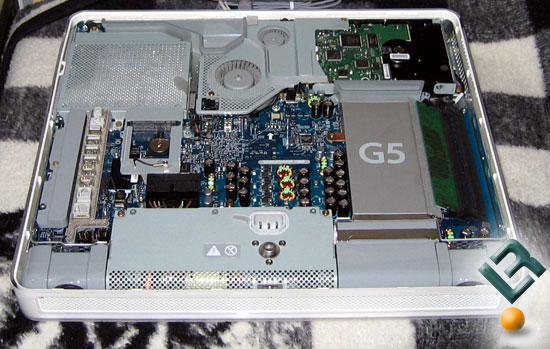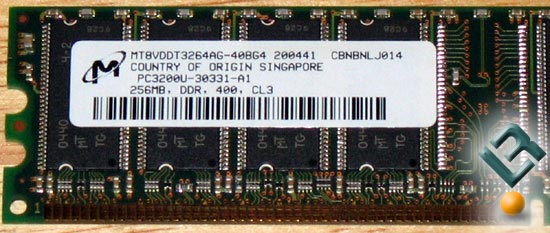Apple iMac G5: How To Install More Memory
Installing Additional Memory
Installing Additional Memory Into An Apple iMac G5:
The Apple iMac G5 is an all-in-one device that integrates the system into the display unit. While the system is sleek with no obvious handles or case doors it is very simple to take apart. First one needs to completely power off their system and unplug all the cables that are plugged into the back of the Apple G5 case. The power cable looks like it is not removable, but a simple tug will reveal that it is nothing more than a standard 3-pin power cable that is found on many IBM and Apple computers. Once all the wires have been removed find a towel or cloth to lay the computer face down on so the screen does not get harmed during the memory upgrade.

Now your system should like like the one pictured above. Once at this point use a philips head screw driver to remove the 3 screws on the bottom of the unit. The screws will not come all the way out as Apple didn’t want them to get lost. Once all the screws are no longer threaded into the chassis gently lift up on the stand to remove the back cover.

Once the cover is removed one can see how tightly Apple crammed everything into the iMac G5 case. Much to our amazement the memory slots are located on the right hand side and nothing needs to be done to access them. The system offers a total of two memory slots that support single channel DDR400 (PC-3200) unbuffered memory modules. This happens to be the most sold type of SDRAM memory in the world, so once again luck was on our side as pricing is very friendly for PC-3200 modules.

Since the system is running in single channel mode you are not required to run identical memory modules. This means that we can add any PC-3200 memory module that we want and still keep our existing 256MB, so it does not go to waste. There is one catch though as the Apple iMac G5 can run in either a 64-bit or 128-but data path depending on if identical modules are used. Right now our Apple iMac G5 runs with a single 64-bit data path on our 256MB memory module. If we installed another 256MB memory module in the open DIMM slot the memory would then run on a 128-bit memory bus. If you are trying to get the most performance out of your G5 then you will want to run matched memory modules. Luckly, most of the big memory companies sell “paired” memory modules for applications like this. The Apple iMac G5 can hold up to 2GB of memory, so keep this in mind when purchasing modules.
In order to purchase a new module we removed the old memory module to find our what timings it was running. While many skip over this step we have found it best to run identical timed modules on the same system. To remove the old module simply unclip the module by pulling the two tabs on each side of the module away from the center.

Once the memory module was removed the label showed that it was made by Micron and features a CAS Latency (CL) of 3, which is a very common setting for value memory. Basically any memory brands value memory series will work on the system and it wont break the bank. Once the new modules are purchased simply open the retainer clips and secure the new module into the memory slot by pushing it gently in till the clips lock the module into place. Make sure you check to make sure the module is inserted correctly via the notch in the middle of the module. Once the module is inserted install the back plate, tighten the three screws, plug in all your cables, and then power up your system. All said and down the memory upgrade on an Apple iMac G5 takes under 10 minutes and is something that is classified as “easy” in terms of ones abilities. If you can turn a screwdriver you can upgrade your Apple iMac G5 memory without having to pay a shop to do it.
Looking at our Shopping.com site we found that pricing for PC-3200 memory modules is very affordable and now you know how easy it is to complete. Remember that it is best to run two paried modules for better performance.
It turns out that for under $30 you can add an additional 256MB memory module and double your system memory capacity and double the memory data bus. This will bring the total system memory up to 512MB and is what we would consider the bare minimum for Mac OS X. If your budget allows you to purchase more memory then go for it because you can never have enough memory. Many current performance desktops ship with 1GB of memory standard, so keep that in mind when trying to update your PC to keep it current.
Now with additional memory you will be able to enjoy OS X and the iLife applications that come with it?iTunes, iPhoto, GarageBand, iMovie, and iDVD without having to suffer from low memory issues. If you are using professional software like Pro Tools you will notice a night and day difference with additional memory.

Comments are closed.